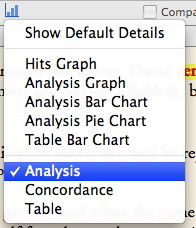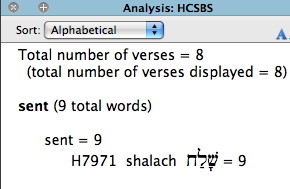This week we’ve been discussing the interpretive value of looking for repeated words in a passage of Scripture, and I’ve been showing how to do this using Accordance’s highlighting tools and other shortcuts. Yesterday, I showed how, having noticed a repeated word, you can quickly search for other occurrences of that word and highlight the results with one click. But I ended that post by discussing the challenges of searching for repetition in a translation rather than in the original Greek or Hebrew:
In most cases, the repetition of a word in a translation actually reflects the repetition of a word in the original Greek or Hebrew, but that’s not always the case. It may be that a Greek or Hebrew word is translated by different English words in the same passage, in which case our search for repetition in English would miss instances of repetition in the original. Conversely, it may be that the same English word is used to translate different Greek or Hebrew words, in which case we would be seeing repetition in the English which is not actually present in the original.
So if you’re working in English, how can you be sure you’re finding repetition which occurs in the original texts? The answer is to use an English Bible tagged with Key numbers that link you to the original Greek and Hebrew words. Accordance has quite a few such texts available (ESVS, HCSBS, JPSS, KJVS, NAS95S, NKJVS, NRSVS, NIV-G/K, and even the Spanish RVR60S), so you likely have at least one such text already.
Yesterday, I did a search for every occurrence of the word “sent” in 2 Samuel 11, and I found 9 occurrences in the HCSBS. How can I be sure that all nine occurrences translate the same Hebrew word? Well, I could hover my cursor over each occurrence and see which Hebrew word appears in the Instant Details box, or I can simply click the Details icon of the Search window and select Analysis from the pop-up menu.
If I do the latter, an Analysis tab will appear listing all the words that were found by my search, as well as all the Key numbers attached to those words. This tells me right away that all nine occurrences of “sent” translate the Hebrew word shalach.
Now, how can I be sure that my search for the English word “sent” found every occurrence of shalach in 2 Samuel 11? The easiest thing to do is to search for the Hebrew word itself. We can do that by right- or control- clicking the English word “sent” and choosing Key Number from the “Search for” submenu of the contextual menu.
This will open a new tab showing every word in the entire Bible which has been tagged with the Key number representing shalach. Since I’m only interested in the occurrences of this word in 2 Samuel 11, I would then limit the search by specifying that chapter as the search range.
Now I can see clearly that my English search actually missed two additional occurrences of the Hebrew word shalach. If I want to highlight those additional occurrences, I can simply shift-click my highlight style again to apply that style to all the hits from this Key number search.
Obviously, I would have saved a step if I had searched by Key Number to begin with, and I’d recommend you make a habit of searching by Key Number rather than by English word. I began with the English word search in yesterday’s post purely for teaching purposes.
Now that I’ve found all eleven times the Hebrew word shalach is used in 2 Samuel 11, I’m ready to begin analyzing each occurrence to see how it develops a theme and decide what that theme communicates. Again, using Accordance to speed up the process of finding all this repetition frees me to do the work of interpretation that no software can do for me.
So far, we’ve been using an English translation as a gateway to study the original Hebrew, but those of you who are comfortable working in the Hebrew directly can go even further. In tomorrow’s post, I’ll show you an even more sophisticated way to find repeated words in a passage.




